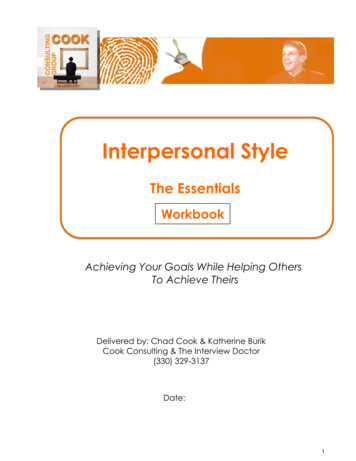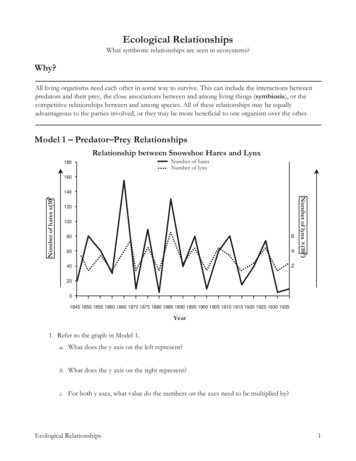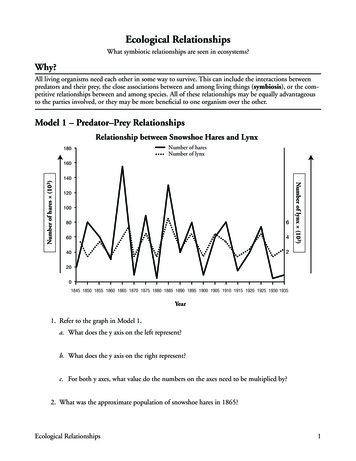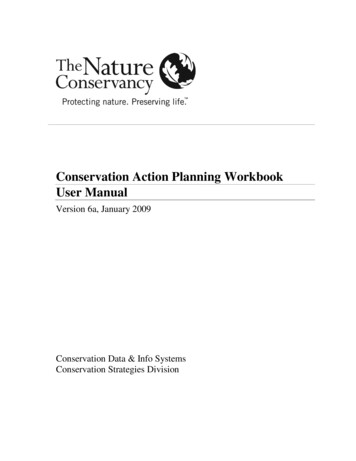
Transcription
Interpersonal StyleThe EssentialsWorkbookAchieving Your Goals While Helping OthersTo Achieve TheirsDelivered by: Chad Cook & Katherine BurikCook Consulting & The Interview Doctor(330) 329-3137Date:1
Style Patterns: The EssentialsWorkbookBehavior PatternsContentsUnderstanding People Differences . . . . .1Pattern IVPattern IStyle Patterns . . . . . . . . . . . . . . . . . . . . . 4Managing Relationships . . . . . . . . . . . . .10Exercises . . . . . . . . . . . . . . . . . . . . . . . . 15Pattern II2013 Cook ConsultingPattern IIIStyle Models. . . . . . . . . . . . . . . . . . . . . . 21chad@cookconsulting.biz1
Understanding People DifferencesGoals Recognize the style differences of others Understand your own style and its impact on others Learn techniques to better meet other’s business and work expectationsBehavior is PredictableThe interpersonal style model hinges on the fact that behavior is predictable. We develop habitual ways of dealing with ourenvironment, and our actions are reinforced through practice as we seek to satisfy our needs in life. Over time, these behaviorsturn into observable patterns, particularly in terms of our efforts to assert ourselves in relationships and to express emotions.Since we behave habitually, we are predictable.These behavior patterns are depicted in the interpersonal style model below.Behavior Patterns I-IVAnalytic IVDriving IThe concept of interpersonal style is built onthe belief that people can learn to improvetheir relationships to the benefit of themselvesand others.This overview booklet is designed for use withthe Interpersonal Style Profile, a personalfeedback instrument that provides an accuratepicture of how a person is perceived by othersbased on two dimensions of behavior;dominance and sociability.An awareness of one’s interpersonal stylealong with guidance on how to applyrelationship-building applications can help aperson improve his or her effectiveness in aAmiable II2013 Cook ConsultingExpressive IIIvariety of situations.chad@cookconsulting.biz2
Understanding People DifferencesNonverbal CommunicationWhen you observe another person’s style, you need to consider their nonverbal behavior.Body language Use of space Voice intonation Becoming a Better ObserverMuch has been written about the meaning of nonverbal communication, yet no dictionary exists. We usually translate thesesilent messages based on instinct, experience and perhaps a little knowledge. A surprising amount of our interpersonalcommunication is nonverbal. Experts tell us that it can be as high as 83%.Understanding the importance of nonverbal communication as it relates to interpersonal style is essential if you are to put themodel to work.DominanceDominance ScaleDefinition: A measurement of a person’s inclination to be forceful, dominant, or assertive in relationships. High scores indicate atendency to direct be direct, outgoing, and vigorous in one’s actions. Low scores indicate a tendency to ask questions, processideas, and defer to others.(D)Tendencyto yield(C)(B)LOW (A)HIGHLeans backCooperative stanceGives up spaceUnassuming speechSpeaks slowly Tendencyto dominateLeans forwardCompetitive stanceAcquires spaceRaises voice for emphasisSpeaks rapidlyEach quartile represents 25% of the population.2013 Cook Consultingchad@cookconsulting.biz3
Understanding People DifferencesSociabilitySociability ScaleDefinition: A measurement of a person’s inclination to show emotions and feelings in relationships. High scores indicate a prosocial and communal orientation toward others. Low scores indicate a tendency to be reserved, cautious, and formal inrelationships.(1)SociallyReserved(2)(3)(4)LOW HIGHActions restrainedLimited body motionLimited facial expressionFormal, orderedLittle voice inflectionSociallyOutgoingActions open Animated flowing gestures Unlimited facial expressions Casual use of space Many voice inflectionsEach quartile represents 25% of the population.Attributes of Successful CommunicatorsEffective communicators are versatile and adaptive. They can draw on an extensive repertoire ofbehaviors in order to meet the needs of others, but more importantly they show empathy in their dailyinteractions. They realize that the same behavior does not work equally well with everyone, and theyadapt their behavior accordingly.1.2.3.4.5.6.7.8.9.10.Learn about people’s needs and preferences.Work on the attitude and skills of empathy—people’s concerns, hopes, dreams, and motivations.Build a genuine rapport by adapting their style to meet the expectations of others.Remember that trust is reciprocal.Ask for feedback (informal and formal) about their effectiveness in managing relationships.Open up to others in a genuine way.Communicate with candor and sincerity.Act as a role model for understanding and accepting others’ styles.Seek first to understand before being understood.Show respect in daily interactions2013 Cook ConsultingStyle Patternschad@cookconsulting.biz4
Style PatternsThe ModelWhen the two dimensions are combined, they form a matrix depicting four distinct behavior patterns commonly known asinterpersonal styles.The Interpersonal Style MatrixReservedAnalytic 4analyticalbehaviorDriving miable 2expressivebehaviorExpressive 3OutgoingImportant Things to Keep in Mind about Interpersonal Styles Everyone has some elements of all four Interpersonal Styles.A person’s Interpersonal Style describes the most evident observable behavior patterns; theirpredominant Comfort Zone. There is no right or wrong place to be.People of each style quadrant are simply different, not better or worse. Each style has both strengthsand challenges. By understanding Interpersonal Style, we can each leverage our style strengths andimprove on our style challenges. We can learn to be more “likeable”2013 Cook Consultingchad@cookconsulting.biz5
Style PatternsThe 16 Quadrant MatrixSub-QuadrantsEveryone has some elements of all four Interpersonal Styles. As a result, it can behelpful to further divide each Interpersonal Style Pattern into 13 Cook A2Strategist-producerB3A3Motivator-doerExplorer xpressivechad@cookconsulting.biz6
Managing RelationshipsManaging RelationshipsRelationship TensionTension is a force that helps shape our behavior patterns—our interpersonal style. It helps define the behavioral map thatguides us along in the world as we adopt actions that meet our needs. This is the positive contribution of tension. But too muchtension can produce negative results in our interactions, particularly when our needs are not met. Tension is a feeling we experience when a need is not met. Tension is something we do to ourselves. Tension can be managed.ComfortHighThe Comfort Zone ContinuumDefines relationship stress or tension as perceived by others in interpersonal interactions. Remain emotionally steady understress.StressHighLow Emo 2013 Cook ConsultingRigidResists changeStubbornImpatientOver reactiveTense efulCalmchad@cookconsulting.biz7
Managing RelationshipsManaging RelationshipsApplying Structure – Orderliness ScaleDemonstrating and applying structure to relationships is a characteristic that helps shape our behavior patterns—ourinterpersonal style. It helps define the behavioral map that guides us along in the world as we adopt actions that meet ourneeds. This is the positive contribution of structure. Others respond to the structure we apply to our relationship with thembased on their need, or lack of need, for structure. They endorse or don't endorse the level of structure we apply to therelationship as indicated in their comfort ratings. Structure is applied based on our personal need for it. Structure can be applied based on our perceived need for others. The level of application of structure can be managed.OrderlinessHighThe Orderliness ScaleMeasures the endorsement level of structure applied to a relationship as perceived by others in interpersonal interactions.Varies based on the perception of others.Low OrderlinessHighLow Low self structureLow applied structureRandomAppears disorganizedTough to pin downAppears haphazard2013 Cook Consulting High OrderlinessHigh self structureHigh applied structureOrganizedLogicalProcess orientedPrioritizeschad@cookconsulting.biz8
Style PatternsCharacteristics of Driving I Styles Quick to actDecisiveLikes challengesDeal with difficult issues quicklyMake things happenBasic Need: AchievementGrowth Action: ListenSnapshotOften referred to as, driving behavior, this style combines high dominance and low sociability. They get results throughassertive and controlled behavior. Action oriented, they are competitive and resourceful. They prefer to deal with immediatelyrelevant issues and excel at defining goals along with a plan to reach them.Their behavior is perceived as direct, forceful, competitive, fast-paced and results-focused. This style prefers a challengingwork environment in which they can define the structure and orchestrate the results. They do not hesitate to make toughdecisions, even if contrary to the desires of others.Strengths Results Oriented Forceful Like challengesChallenges Poor listener Insensitive UnyieldingStrategies for Working with this StylePlan actions that are . . . Clear, specific, briefBusinesslike, results orientedSpecific when asking questionsOrganized with alternatives, options and choicesPresented with facts about probabilitiesWith support for their conclusions and actionsReady to stress results2013 Cook ConsultingAvoid actions that are . . . Vague, time wastingPersonal, informal, casualPretentious, irrelevantConclusive or arbitraryCareless with facts and forecastsDirect or forcefulPersonalizing the decisionchad@cookconsulting.biz9
Style PatternsCharacteristics of Amiable II Styles SupportiveGood listenersAsk questionsShare personal feelings and emotionsTeam playersBasic Need: SecurityGrowth Action: InitiateSnapshotOften referred to as amiable behavior, this style combines low dominance and high sociability. They readily show their feelingsand are not particularly aggressive. Relationship-oriented, these styles tend to be supportive and seek cooperation throughteamwork. As team leaders, they recognize and encourage active participation. Relationship building is a major strength.Their behavior is perceived as friendly, unassuming, and supportive. They are seen, as warm individuals who tend to give andreceive trust easily. They place a high value on maintaining positive relationships in a harmonious manner.Strengths Good listener Sensitive to others Team playerChallenges Too trusting Not able to confront Too easy-goingStrategies for Working with this StylePlan actions that are . . . Candid, open, patientShowing personal interestPatient, responsive to their ideasSupporting teamwork and harmonyHaving a well defined idea but negotiableSupporting win/win relationshipsReady to provide “fail-safe” plan2013 Cook ConsultingAvoid actions that are . . . Loosely organized, unstructuredInformal, too casualToo general about your planVague about what is expected of each partyLeaving loose ends; poor follow-throughToo reliant of othersUnrealistic or aggressive about deadlineschad@cookconsulting.biz11
Style PatternsCharacteristics of Expressive III Styles Quick pacedStimulatingPrefer involvementTake risksPersuasiveBasic Need: RecognitionGrowth Action: CheckSnapshotOften referred to as expressive behavior, this style combines high dominance with high sociability. They express strong feelingsabout their goals. They often rely on their intuition to guide their actions, engaging and inspiring others to follow along. With afuture orientation, they are able to show others the big picture. They are persuasive competitors.Typically vigorous, outspoken, and resourceful, Pattern III styles emphasize interaction and involvement with others whenworking toward a goal. Leadership is premised on influence and persuasion rather than control.Strengths Persuasive Instinctive EnthusiasticChallenges Impulsive Too general CarelessStrategies for Working with this StylePlan actions that are . . .Avoid actions that are . . . Supporting their ideas and concepts Stimulating, thought provoking Discussing other’s successes Encouraging commitment to a plan Seeking their opinions and ideas about people Contributing ideas to a plan Offering incentives to take risks 2013 Cook ConsultingArbitrary of directiveUnyielding, too structuredToo rigid about the planWasting time on formalities and protocolEmphasizing concepts too muchDirect or forcefulSticking too tightly to a formal agendachad@cookconsulting.biz12
Style PatternsCharacteristics of Analytic IV Styles Seeks facts and dataTime disciplinedProblem solving skillsConservativePracticalBasic Need: To be rightGrowth Action: DeclareSnapshotOften referred to as analytical behavior, this style Combining low sociability with low dominance. They are planners andorganizers. Thinking oriented, they prefer to work alone or in a small group. Their decisions are based on critical thinking and athorough examination of the facts. They are risk averse.Thorough, logical and cautious are good descriptors of this style. Pattern IV styles are focused on quality. Leadership ispremised on competence and know how rather than forcefulness and persuasion. They are characterized as businesslike andobjective in dealing with others.Strengths Thorough Crit ical thinker Detail orientedChallenges Aloof Poor improvise r Slow decision -makerStrategies for Working with this StylePlan actions that are . . . Well prepared, having an agendaDirect, orderly, patientOriented toward specificsDoing what you say you will doPrepared with a schedule including action stepsAmenable toward verifying the planHaving timeline with follow-up plan2013 Cook ConsultingAvoid actions that are . . . Loosely organized, unstructuredInformal, casualToo general, informal planVague about what is expected of each partyLeaving loose ends; no follow-through planToo reliant on assumptionsUnrealistic plan and deadlinechad@cookconsulting.biz13
Managing RelationshipsSummary of Style ElementsStylePattern IPattern IIPattern IIIPattern IVBasic OrientationActionRelationshipsIntuitionThinkingUse of TimeImmediatePresentFutureHistoricalRelating to OthersTask firstKey priorityLikes an audienceCautious actionsTasksPrimary importanceRelationships mostimportantMust be excitingProcess takespriorityDecision-makingQuick, goal orientedSlow, peopleorientedFast, intuitionorientedSlow, processorientedAction planningquestionsWhat?Why?Who?How?Maximum Efforttoward othersControlRelationshipsInvolvementProcessFirst e of TensionInactionConflictIsolationInvolvementMajor r WeaknessTends to beInsensitive to other’sfeelingsTends to avoidsconfrontationTends to actimpulsivelyMay be reluctant toimproviseFallback y team has a common goal or mission along with structures and processes that make it function. The success of a team,however, depends on mutual cooperation and support. As you review the chart above, it should be apparent that the strength ofone style may be the weakness of another. An awareness of each other’s styles helps you to appreciate the potential of eachindividual and how he or she can not only contribute to the success of the team, but also make work much more fun!2013 Cook Consultingchad@cookconsulting.biz14
Managing RelationshipsStyle StretchingAn awareness of your style along with skill atmeeting the style needs of others will help you toimprove your overall effectiveness.If you are perceived as . . .Socially ReservedTake actions to . . . Say what you feel. Make personal remarks. Devote more time to relationships. Engage in small talk.Socially Outgoing Talk less. Restrain enthusiasm/feelings. Make decisions based on solid evidence. Acknowledge opinions of others.Less Dominant Volunteer opinions and information. Make points clearly. Be willing to disagree. Initiate conversations.More Dominant Listen without interrupting. Talk less and ask for others’ opinions more. Adapt to time needs of others. Allow others to take the lead.2013 Cook Consultingchad@cookconsulting.biz15
Managing RelationshipsThe Versatile Relationship ManagerInterpersonal Style can be an important tool to improve your relationships. It can help you to create more productiverelationships. You can learn to meet the leadership expectations of others more often by temporarily abandoning your stylepreferences, Comfort Zone, and moving into the other person’s arena of expectations.Interpersonal Style is an empathy tool. You can use it to better understand yourself and others, and to improve the quality andeffectiveness of your relationships. When a person exhibits a behavior, Interpersonal Styles helps to avoid “making stuff up”since it is based on what we observe rather than our judgment.Key ActionsStyleQuestion?Driving 1What?Amiable 2Use ofTimeHelp Them DecideConclusions and actionsEfficientlyOptions with probabilitiesWhy?Teamwork and harmonyAgreeablyAssurances and supportExpressive 3Who?Ideas and conceptsFlexiblyIdeas and incentivesAnalytic 4How?Principles and thinkingAccuratelyEvidence with service2013 Cook ConsultingSupportchad@cookconsulting.biz16
Exercise: Personal Action PlanStyle Identification Checklist(Make copies of this page)CDPerson observed: AB1For each of the 18 items below,circle the number or letter that bestdescribes the person.Count the number of circles in eachcolumn of letters and numbers. Putthe totals on the total line.Put an “X” in the square of the gridthat represents the letter and numberwith the highest total count.234DominanceSociabilityaccepting . confrontingDCBArigid . flexible1234reticent . outspokenDCBAcalm . excitable1234go along . take chargeDCBAserious . fun-loving1234compliant . dominantDCBAcold . warm1234non-assertive . assertiveDCBAformal . informal1234deliberative . decisiveDCBAreserved . sociable1234asks questions . states ideasDCBAguarded. open1234slow-paced. fast-pacedDCBAlittle movement. frequent movement1234cooperative . competitiveDCBAcontrolled . animated1234TotalTotalDC2013 Cook ConsultingBA1234chad@cookconsulting.biz17
Exercise: Personal Action PlanDCBAExacting, orderly, preciseRelies on facts and logic. Exploresall avenues before making adecision. Preferred leadershipstyle based on competence ratherthan force. Completes projects ina focused manner. In stressfulsituations may avoid peopleinvolvement.Reserved, conservative, orderlyPrefers a situation that calls forindependent analysis or expertise.Tends to lead by example. Enjoysa leadership role in which knowhow and technical expertise areimportant. Will strive for a logicalsolution.Controlling, task-oriented,formalStrives for accuracy anddependability in performance. Asituation that depends on technicalexpertise satisfies control needs.Leads by example rather thanfeelings. May down play theimportance of relationships.Takes charge, competitive, taskorientedPrefers to deal with immediatelyrelevant issues. Defines goals witha means of reaching them. Valuesand rewards loyalty among teammembers. Achievement oriented.Under stress may becomeunyielding.Moderate, restrained, methodicalWorks best alone and on clearlydefined tasks. Good listener.Tends to influence through reasonrather than power. May bereluctant to direct orders. May relyon expertise more than assertion tosucceed.Task-oriented, cooperative,practicalTends to depend on themselves toget the job done, but recognizesthe need for cooperation andsupport. Will reach out to peers.Usually responds to feedback well.Resolves conflict by combiningreasoning with diplomacy.Purposeful, business-like,moderateWorks best in a well-definedsituation in which they determinethe course to follow. Likes to beviewed as the authority figure, butprefers “win/win.” May be seen assingle-minded. Tends to rely onpower and position.Straightforward, competitive,aggressiveComfortable in directing others.Can influence by their personalforce. Often perceived as singleminded and too assertive. When asituation is consistent with theirgoals they will support a teameffort. Praise is a motivator.Unpretentious, friendly,consistent.Tends to be an effective listenerand usually gains endorsementthrough good diplomatic skills.Prefers to motivate by examplerather than authority. Tends to likewell defined tasks. May beuncomfortable directing others.Efficient, cooperative, realisticTends to generate confidence andtrust through persuasion ratherthan force. Can be direct andassertive to maintain support.Generally supportive andcooperative. Most effective insituations needing a moderate,conservative stance.Sociable, moderate, tactfulUsually concerned with theimportance of relationships and arewilling to listen to another person’spoint of view. Prone to influencethrough persuasion, but tries tobalance the need to achieve theneed for acceptance. May rely tooheavily on persuasion to results.Outgoing, outspoken,stimulatingCompetition and involvement arekey. They are persuasivecompetitors. Will put forth a strongeffort to achieve recognition andreward. Won’t hesitate to expressopinions strongly. May be overlyaggressive in stressful situations.Supportive, informal,cooperativeTends to have strong social drives.May depend on feelings more thanfact or necessity when makingdecisions. Prefers to deal withpresent day issues. May be tootrusting and accepting. May not beable to confront tough issues.Supportive, responsive,agreeableEspecially responsive to others’point of view. Generally thought ofas a team player. May go with theconsensus rather than take anindependent stand. Relaxed withothers and listens well. Respondswell to constructive criticism.Enthusiastic, visionary,supportiveSensitive to the importance ofrelationships. Can deal with avariety of views tactfully,particularly in a group setting. Ateam player. Skillful at gettingconsensus decisions. Respondswell to input from others.Spontaneous, enthusiastic,futuristicTends to be strongly extroverted.Will emphasize interaction andinvolvement when working towarda goal. Often focuses on highvisibility task directed at a futuregoal. Can elicit a strong response,particularly in stressful situations.2013 Cook Consultingchad@cookconsulting.biz123418
Personal Action Plan(Make copies of this page)DCBAStyle Stretch StrategiesYou can modify your style to meet theexpectations of similar and different styles.Use the Style Identification Checklist todetermine the style of the person with whomyou would like to improve your relationship.Place an “X” on the grid to mark his/her style.Determine your style stretch objective byPlacing an “M” next to the position that youwould like to be on the matrix in order to bemost effective with the other person.1234Then respond to the following:Person’s Name:I will modify my tendency to be reserved/open. Place an “X” in one of the following: increase decrease no changeI will modify my tendency to dominate/yield. Place an “X” in one of the following: increase decrease no changeSelf Management Strategies:I plan to meet my relationship objectives with this person by stretching my style preferences as follows:Support:Use my time:Encourage decisions:Versatility Performance Goal2013 Cook Consultingchad@cookconsulting.biz19
Useful Tips Ask yourself whether you adjust your interpersonal style to fit the situation, or whether you expect the situation tofit your style. Gather feedback from trusted colleagues when your style is not working for you. Remember the law of the harvest; in a relationship you will reap what you sow. View sharing information as an opportunity rather than a burden. First seek to understand, then to be understood. Project confidence when you communicate. Avoid mixed signals; people tend to interpret the worst case possibility. Determine two or three behaviors that if adopted would result in improved performance. Thank people for constructive feedback and recognize how difficult it may be to provide. Be part of the solution, not part of the problem. Identify whether your organization has a preferred interpersonal style, and how that affects your own performance. Determine whether people expect you to interact in a certain way and how that may affect your relationshipproductivity. Sometimes you have to apply more of your preferences to help others achieve what they want to achieve. Betransparent about it and why you are doing it to create a win/win/win for everyone involved.2013 Cook Consultingchad@cookconsulting.biz20
16 Quadrant Matrix – Other LinksMBTI, Disc, Insights, Wilson Learning, HRDQ StylePattern IVPattern IIPattern ICool BlueFiery RedDiSC “C”DiSC “D”Earth GreenSunshine YellowDiSC “S”DiSC “I”Pattern III21
Workbook . 2013 Cook Consulting chad@cookconsulting.biz 1 Style Patterns: The Essentials Behavior Patterns Workbook Pattern I Pattern II Pattern III Pattern IV . Relationship-oriented, these styles tend to be supportive and seek cooperation through teamwork. As team leader










